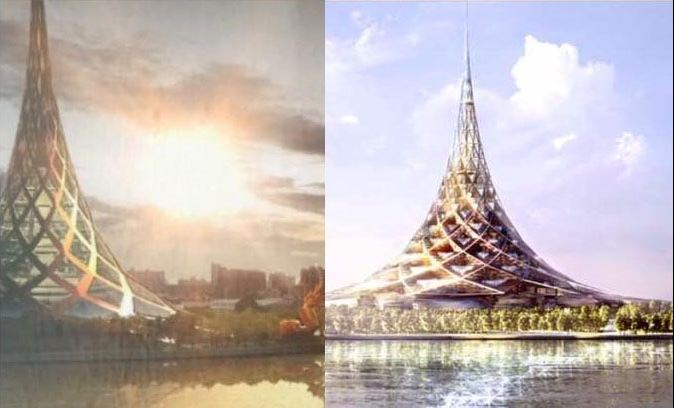Thai media exploded yesterday when the country’s star architect, Duangrit Bunnag, took to social media with claims that the proposed signature building that’s part of the government’s riverside promenade project was a copycat design.
He said that the major design element of the recently unveiled project, a cone-shaped building called Viman Pra In, was a direct copy of world-renowned British architect Norman Foster’s Russia Tower in Moscow.

The building on the left is the museum proposed for the riverside…and the one on the right is the British architect’s design. Photo: Friends of the River/Facebook
A vocal opponent of the riverside project and it’s bloated THB14,000 million price tag, Duangrit smelled a rat when he first saw plans for the proposed building a few weeks ago. He began talking to some of his colleagues about it, including members of the Friends of the River project. The consensus was, “We thought it looked very familiar. Like that Norman Foster building in Russia.”
“We compared both buildings and found a lot of similarities that could not be explained or accidentally achieved.”
The building was designed by a team of architects associated with King Mongkut’s Institute of Technology Ladkrabang in Bangkok.
It wasn’t until a few days ago that some of Duangrit’s colleagues searched online and found a free, ready-made 3D model of Russia Tower that could be downloaded.
“You can manipulate the model. We downloaded it and tried playing around with it. We found that we could replicate, precisely, the riverside building by changing the proportions and articulations of Foster’s design,” he said.
This created two issues in Duangrit’s mind. First, whether or not the designers intended to imitate the work of Norman Foster by using this online model and, second, whether it’s ethical to charge the government a design fee if a ready-made 3D model was used for the proposal.
“These two issues turned into a prominent conversation yesterday,” said Duangrit.
He’s not trying to start a war, but rather, to protect the integrity of his beloved profession.
“It’s just a conversation. Part of the reason I raised this is because I don’t want to see the industry based on copying other people’s ideas. It’s a very important conversation that I’m trying to create. I want to make sure that any form of formal practice, especially architects that work for the government, should not try to imitate, especially on such a significant building.”
The designers from King Mongkut held a press conference a few days ago where they countered the points made against them. They claimed they had never seen Foster’s building or the online plans for it. Instead, they claimed that they were inspired by the Sukothai-era Jom Hae Stupa.
Duangrit has reached out to Foster + Partners, the worldwide architecture firm of Norman Foster, about the possible copycat. They have not publicly responded. “I don’t think they’ll make a formal comment but I wanted to reach out for the sake of practice integrity.”
He also has issues with the copycat design on a philosophical level. “For me, the only way that architecture can be created is against the context of a city and in its cultural context. It doesn’t have to look like a Thai building, but it has to relate to its surroundings. If this building was created by borrowing the [context of surroundings in Russia] without any kinship or relationship to the area by our river, it’s not a building that I can accept,” he said.
Duangrit has been publically opposed to the government’s riverside promenade project because, in his opinion, it’s unnecessary.
“When you design something of this magnitude, it should be driven by the need of society and the people who live in that area. In other countries, when they want to come up with a large-scale project, they talk with the community and the people in the area for years to figure out the way to do it. This was developed in only a few months and the need for it is not well-established.”
“You can do a waterfront development project but it doesn’t have to be 14 kilometers on the waterfront and so expensive. Nobody can tell me why it has to be so big. Why can’t it just be one kilometer?” he asked.
Duangrit is a proponent of bringing life back to the riverside. He moved his own headquarters there a few years ago in a complex he created called The Jam Factory.
However, he’s not a fan of doing it with taxpayer money.
“We don’t need to do anything to the riverfront now. If you step back and look at Bangkok, there’s a lot we have to do: traffic, flood, garbage and education. We can use that money for something that we really need. Instead of using the city’s limited budget for this, why not improve traffic, education and drainage? I think this isn’t relevant, it doesn’t make sense. Let’s use the money for something we need.
“When we sit in traffic for hours because of flooding, are we dreaming of a riverside promenade? No, it’s ridiculous.”




